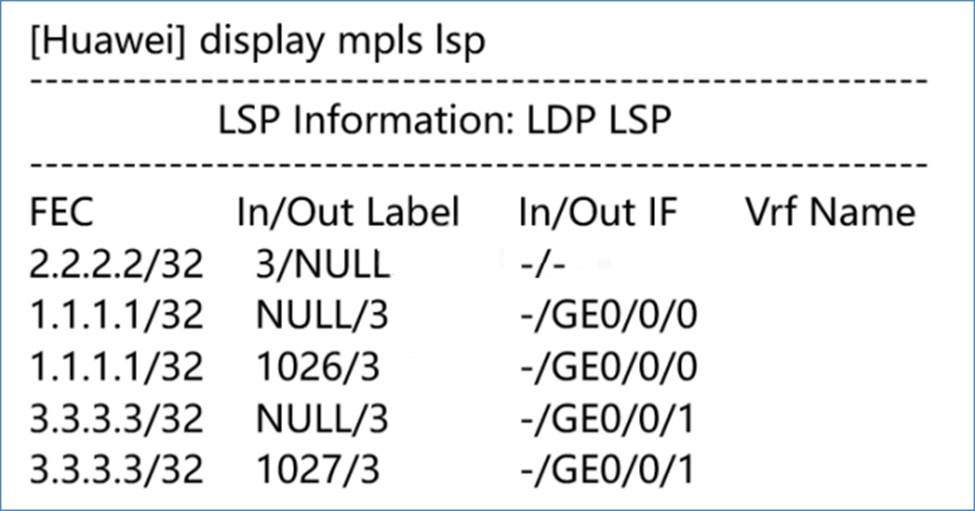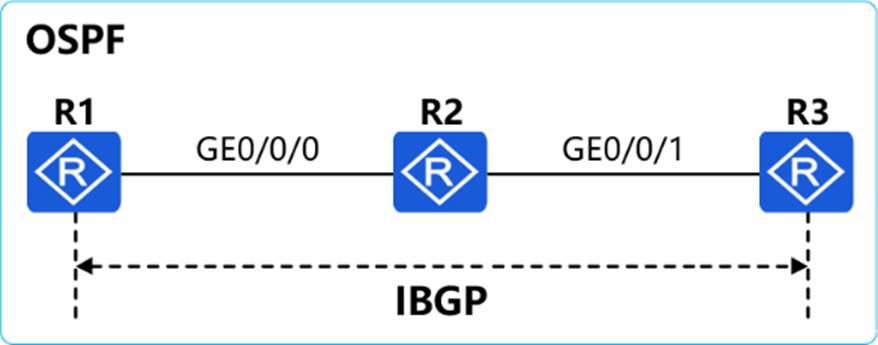Practice Free H12-831_V1.0-ENU Exam Online Questions
The administrator uses the display mpls lsp command to view the LSP of the device. The output information is shown in the figure.

Which of the following descriptions of the information are correct? (Multiple choice)
- A . Traffic from the access port 1.1.1.1 sent from the GE0/0/0 port of the device will carry label 1026
- B . For traffic accessing 1.1.1.1, this device is the last hop, i.e., the Egress device
- C . For traffic accessing 3.3.3.3, this device is the penultimate transit device.
- D . Traffic from the GE0/0/1 port of the device to access 3.3.3.3 will not carry a label
OSPF supports equal-cost load balancing. When the number of equal-cost routes in the network is greater than the number of equal-cost routes configured by the maximum load-balancing command, if the interface priority and interface index are the same, load balancing selects the route with a smaller next-hop IP address.
- A . True
- B . False
OSPF neighbors periodically send Hello messages to establish and maintain adjacency, and the interval of the Hello timer must be consistent, otherwise the adjacency cannot be established. In order to accelerate OSPF convergence, network engineers can set the interval of the Hello message to 1ms.
- A . True
- B . False
In the network shown in the figure, PC1 and PC2 are connected to the same switch and belong to the same VLAN.

Which of the following reasons may cause PC1 and PC2 to be unable to communicate with each other? (Multiple choice)
- A . SW1 is configured with port isolation
- B . SW1 GE0/0/2 interface is shut down
- C . SW1 GE0/0/1 interface link failure
- D . The host has wrong static ARP configuration
In the OSPF network shown in the figure, the area numbers are marked in the figure. Area 1 is a stub area, area 2 is a totally stub area, and area 3 is an NSSA area.

Which of the following types of LSAs will not appear in areas 1, 2, and 3?
- A . Type1
- B . Type3
- C . Type4
- D . Type2
On the OSPFv3 network shown in the figure, OSPFv3 is enabled on the interfaces connecting R1, R2, and R3. The router ID of each router is 10.0.X.X, where X is the number of the router.
If you check detailed information about an LSA on R3, the command output shows that R1 and R2 are DRs on the network.
- A . TRUE
- B . FALSE
B
Explanation:
Comprehensive and Detailed In-Depth
LSR (Label Switching Router) discovers LDP peers through the LDP discovery mechanism and establishes LDP sessions.
Which of the following descriptions of LDP sessions are correct? (Multiple choice)
- A . The LSR with a larger transmission address actively initiates the establishment of a TCP link
- B . LSR sends Hello message based on UDP
- C . LSR can establish a local LDP session or a remote LDP session based on the LDP discovery mechanism
- D . LSR discovers LDP peers by sending multicast or unicast Hello messages
In a BGP/IPLS IP VPN network, the output information of a PE device VPN1 is shown in the figure.
ip vpn-instance VPN1
ipv4-family
route-distinguisher 100:1
vpn-target 100:1 200:1 300:1 export-extcommunity
When the VPIv4 route corresponding to VPN1 is advertised to the remote PE, which VPNs of the remote PE will receive the route? (Multiple choice)
- A . VPN1: Import RT=100:1
- B . VPN4: Import RT=500:1
- C . VPN2: Import RT=200:1, 400:1
- D . VPN3: Import RT=100:1, 300:1
In the network shown in the figure, OSPF protocol is run between R1, R2, and R3. IBGP neighbor relationship is established between R1 and R3 using loopback interface.

If OSPF is shut down on R2’s GE0/0/1 interface through "undo network xxxx yyyy" command, and BGP neighbor relationship is checked on R1, by default, the longest time for R1 BGP neighbor relationship to change from Up state to Dom state is which of the following?
- A . 10s
- B . 180s
- C . 60s
- D . 40s
In the network shown in the figure, R1, R2, R4, and R5 run IS-IS, and the area number is 49.0001. R3 and R6 run IS-IS, and the area number is 49.0002. Inside AS65000, R1, R3, R4, and R6 all establish IBGP neighbor relationships with R2 and R5, of which R2 and R5 are RRs and R1, R4, R3, and R6 are clients. IBGP neighbor relationships are all established using the Loopback0 interface. The IP address of the Loopback0 interface of each device is 10.0.X.X/32, and the Router ID is 10.0.X.X, where X is the device number. R1 and R4 introduce the external network 192.168.1.0/24 into BGP through the import method, and R3 and R6 introduce the external network 192.168.2.0/24 into BGP through the import method.

By default, which of the following descriptions are correct? (Multiple choice)
- A . For 192.168.1.0/24, the Originator_ID attribute carried by R2’s preferred BGP route is 10.0.1.1
- B . For 192.168.1.0/24, the Originator_ID attribute carried by R6’s preferred BGP route is 10.0.1.1
- C . For 192.168.1.0/24, R5 prefers the route received from R1
- D . For 192.168.1.0/24, the Originator_ID attribute carried by R3’s preferred BGP route is 10.0.2.2
